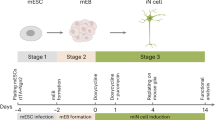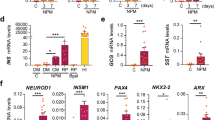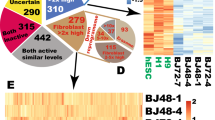Abstract
Terminally differentiated cells can be directly converted into different types of somatic cells by using defined factors, thus circumventing the pluripotent state. However, low reprogramming efficiency, along with the absence of proliferation of some somatic cell types, makes it difficult to generate large numbers of cells with this method. Here we describe a protocol to directly convert mouse fibroblasts into self-renewing induced neural stem cells (iNSCs) that can be expanded in vitro, thereby overcoming the limitations associated with low reprogramming efficiency. The four transcription factors required for direct conversion into iNSCs (Sox2, Klf4, Myc (also known as c-Myc) and Pou3f4 (also known as Brn4)) do not generate a pluripotent cell state, and thus the risk for tumor formation after transplantation is reduced. By following the current protocol, iNSCs are observed 4–5 weeks after transduction. Two additional months are required to establish clonal iNSC cell lines that exhibit retroviral transgene silencing and that differentiate into neurons, astrocytes and oligodendrocytes.
This is a preview of subscription content, access via your institution
Access options
Subscribe to this journal
Receive 12 print issues and online access
$259.00 per year
only $21.58 per issue
Buy this article
- Purchase on Springer Link
- Instant access to full article PDF
Prices may be subject to local taxes which are calculated during checkout



Similar content being viewed by others
References
Takahashi, K. & Yamanaka, S. Induction of pluripotent stem cells from mouse embryonic and adult fibroblast cultures by defined factors. Cell 126, 663–676 (2006).
Tapia, N., Han, D.W. & Scholer, H.R. Restoring stem cell function in aged tissues by direct reprogramming? Cell Stem Cell 10, 653–656 (2012).
Buganim, Y. et al. Direct reprogramming of fibroblasts into embryonic Sertoli-like cells by defined factors. Cell Stem Cell 11, 373–386 (2012).
Caiazzo, M. et al. Direct generation of functional dopaminergic neurons from mouse and human fibroblasts. Nature 476, 224–227 (2011).
Efe, J.A. et al. Conversion of mouse fibroblasts into cardiomyocytes using a direct reprogramming strategy. Nat. Cell Biol. 13, 215–222 (2011).
Ginsberg, M. et al. Efficient direct reprogramming of mature amniotic cells into endothelial cells by ETS factors and TGF-β suppression. Cell 151, 559–575 (2012).
Han, D.W. et al. Direct reprogramming of fibroblasts into epiblast stem cells. Nat. Cell Biol. 13, 66–71 (2011).
Huang, P. et al. Induction of functional hepatocyte-like cells from mouse fibroblasts by defined factors. Nature 475, 386–389 (2011).
Ieda, M. et al. Direct reprogramming of fibroblasts into functional cardiomyocytes by defined factors. Cell 142, 375–386 (2010).
Marro, S. et al. Direct lineage conversion of terminally differentiated hepatocytes to functional neurons. Cell Stem Cell 9, 374–382 (2011).
Pang, Z.P. et al. Induction of human neuronal cells by defined transcription factors. Nature 476, 220–223 (2011).
Pfisterer, U. et al. Direct conversion of human fibroblasts to dopaminergic neurons. Proc. Natl. Acad. Sci. USA 108, 10343–10348 (2011).
Sekiya, S. & Suzuki, A. Direct conversion of mouse fibroblasts to hepatocyte-like cells by defined factors. Nature 475, 390–393 (2011).
Son, E.Y. et al. Conversion of mouse and human fibroblasts into functional spinal motor neurons. Cell Stem Cell 9, 205–218 (2011).
Szabo, E. et al. Direct conversion of human fibroblasts to multilineage blood progenitors. Nature 468, 521–526 (2010).
Vierbuchen, T. et al. Direct conversion of fibroblasts to functional neurons by defined factors. Nature 463, 1035–1041 (2010).
Han, D.W. et al. Direct reprogramming of fibroblasts into neural stem cells by defined factors. Cell Stem Cell 10, 465–472 (2012).
Kim, J. et al. Direct reprogramming of mouse fibroblasts to neural progenitors. Proc. Natl. Acad. Sci. USA 108, 7838–7843 (2011).
Lujan, E., Chanda, S., Ahlenius, H., Sudhof, T.C. & Wernig, M. Direct conversion of mouse fibroblasts to self-renewing, tripotent neural precursor cells. Proc. Natl. Acad. Sci. USA 109, 2527–2532 (2012).
Ring, K.L. et al. Direct reprogramming of mouse and human fibroblasts into multipotent neural stem cells with a single factor. Cell Stem Cell 11, 100–109 (2012).
Thier, M. et al. Direct conversion of fibroblasts into stably expandable neural stem cells. Cell Stem Cell 10, 473–479 (2012).
Takahashi, K. et al. Induction of pluripotent stem cells from adult human fibroblasts by defined factors. Cell 131, 861–872 (2007).
Maherali, N. et al. Directly reprogrammed fibroblasts show global epigenetic remodeling and widespread tissue contribution. Cell Stem Cell 1, 55–70 (2007).
Han, J. et al. Tbx3 improves the germ-line competency of induced pluripotent stem cells. Nature 463, 1096–1100 (2010).
Cacci, E. et al. Generation of human cortical neurons from a new immortal fetal neural stem cell line. Exp. Cell Res. 313, 588–601 (2007).
Bonaguidi, M.A. et al. Noggin expands neural stem cells in the adult hippocampus. J. Neurosci. 28, 9194–9204 (2008).
Marthaler, A.G. et al. Reprogramming to pluripotency through a somatic stem cell intermediate. PLoS ONE 8, e85138 (2013).
Livak, K.J. & Schmittgen, T.D. Analysis of relative gene expression data using real-time quantitative PCR and the 2(–ΔΔC(T)) method. Methods 25, 402–408 (2001).
Acknowledgements
We thank C. Ortmeier and M. Sinn for technical assistance, and M. Stehling for FACS sorting. This research was supported by the Basic Science Research Program through the National Research Foundation of Korea (NRF) funded by the Ministry of Education, Science and Technology (2011-0013885) and also by a grant from the Next-Generation BioGreen 21 program (PJ009038), Rural Development Administration, Republic of Korea.
Author information
Authors and Affiliations
Contributions
S.M.K. and H.F. were involved in protocol design as well as in the generation and characterization of iNSCs; A.H., S.C.L., Sung Ho Lee, E.H.S., Seung Hyun Lee, A.S. and H.T.L. carried out iNSC characterization; M.J.A.-B. analyzed the microarray analysis; H.R.S. edited the manuscript; and N.T. and D.W.H. were involved in protocol design, generation and characterization of iNSCs, and manuscript preparation.
Corresponding authors
Ethics declarations
Competing interests
The authors declare no competing financial interests.
Rights and permissions
About this article
Cite this article
Kim, S., Flaßkamp, H., Hermann, A. et al. Direct conversion of mouse fibroblasts into induced neural stem cells. Nat Protoc 9, 871–881 (2014). https://doi.org/10.1038/nprot.2014.056
Published:
Issue Date:
DOI: https://doi.org/10.1038/nprot.2014.056
This article is cited by
-
Stem Cell Therapy in Spinal Cord Injury-Induced Neurogenic Lower Urinary Tract Dysfunction
Stem Cell Reviews and Reports (2023)
-
OCT4 protein and gene expression analysis in the differentiation of spermatogonia stem cells into neurons by immunohistochemistry, immunocytochemistry, and bioinformatics analysis
Stem Cell Reviews and Reports (2023)
-
Therapeutic potential of stem cells for treatment of neurodegenerative diseases
Biotechnology Letters (2020)
-
Chemical Reprogramming of Somatic Cells in Neural Direction: Myth or Reality?
Bulletin of Experimental Biology and Medicine (2019)
-
Transdifferentiation: a new promise for neurodegenerative diseases
Cell Death & Disease (2018)
Comments
By submitting a comment you agree to abide by our Terms and Community Guidelines. If you find something abusive or that does not comply with our terms or guidelines please flag it as inappropriate.



